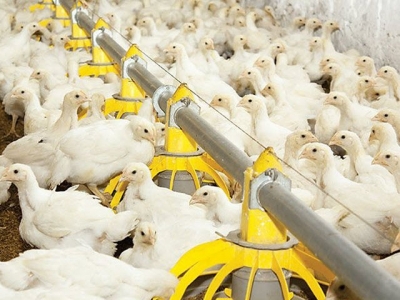How to improve the efficiency of corn-soy poultry diets

By addressing a wide range of chemical bonds present in corn NSPs, the feedase concept has demonstrated significant benefits on energy uplift and the release of other nutrients. | Kharkhan_Oleg, iStock
New research has shown positive effects on broiler performance when a wide range of NSP-degrading enzymes are included in the diet
Non-starch polysaccharides (NSPs) are the main constituents of plant cell walls and play a role in the encapsulation of nutrients including amino acids, starch and lipids. It is well known that NSPs negatively affect access of endogenously secreted enzymes to their substrates, reducing digestibility.
Plant feed ingredients commonly used in poultry diets contain between 7 and 19 percent of NSPs. Cereals like wheat and barley and protein sources like soy contain a higher proportion of NSPs compared with corn. However, the total NSP content of corn and wheat are not so different, close to 90 grams per kilogram. The major difference between corn and wheat NSPs is the kind of arabinoxylan structures present in each.
Arabinoxylans from corn have a much more complex structure than arabinoxylans from wheat. They are highly branched with multiple arabinose residue substitutions in corn. A recent study showed that the arabinose:xylose ratio (A:X) obtained for a corn-based diet was higher than that obtained for a wheat-based diet (0.73 vs 0.65). This demonstrates a higher degree of substitution in corn arabinoxylan chains (AX), compared with those in wheat.
There is still knowledge to be acquired on the impact of indigestible components within many feed ingredients, including corn and soy. By understanding the complex nature of the NSP content in these major feed ingredients, there is also the potential to improve the digestibility of feed. By quantifying their NSP content, along with any other important anti-nutritional factors present, it is possible to estimate the indigestible fraction of a feed that is available to enzymes.
Not all carbohydrases act similarly on the NSP components, because they are a variable substrate. That is why, by adding different carbohydrases in the same basal diet, different effects are seen in animals.
In the previously mentioned study, the dry matter digestibility (dig DM) of wheat- and corn-based diets were assessed. This was carried out without enzyme addition, in the presence of xylanase alone, or xylanase plus arabinofuranosidase (ABF). Compared with dig DM of wheat, the 11 percent lower degree of substitutions in wheat, decreased the dig DM by 31 percent compared to corn. More than that, xylanase alone increased wheat dig DM by 4.0 percent versus the control, but had no significant effect on corn dig DM in this study. However, the combination of xylanase and ABF had a significant effect on dig DM in corn-based diets.
About Authors:
Adriana is Adisseo's regional manager of technical development for Brazil and other South American countries.
Marcio Ceccantini is Adisseo's global director for technical and scientific support in food digestibility solutions.
Related news
 How to Raise Chickens for Farm-Fresh Eggs
How to Raise Chickens for Farm-Fresh Eggs From choosing breeds and caring for chicks to tricking out a coop here's what you need to get crackin'.
 N&H TOPLINE: Researchers develop method for making new vaccines
N&H TOPLINE: Researchers develop method for making new vaccines New method will allow ILT virus to be much more easily manipulated and provides a platform for future vaccine development.
 Blackhead control becoming multi-factorial systems approach
Blackhead control becoming multi-factorial systems approach Medications previously available to control blackhead disease in turkeys have been withdrawn from marketplace.